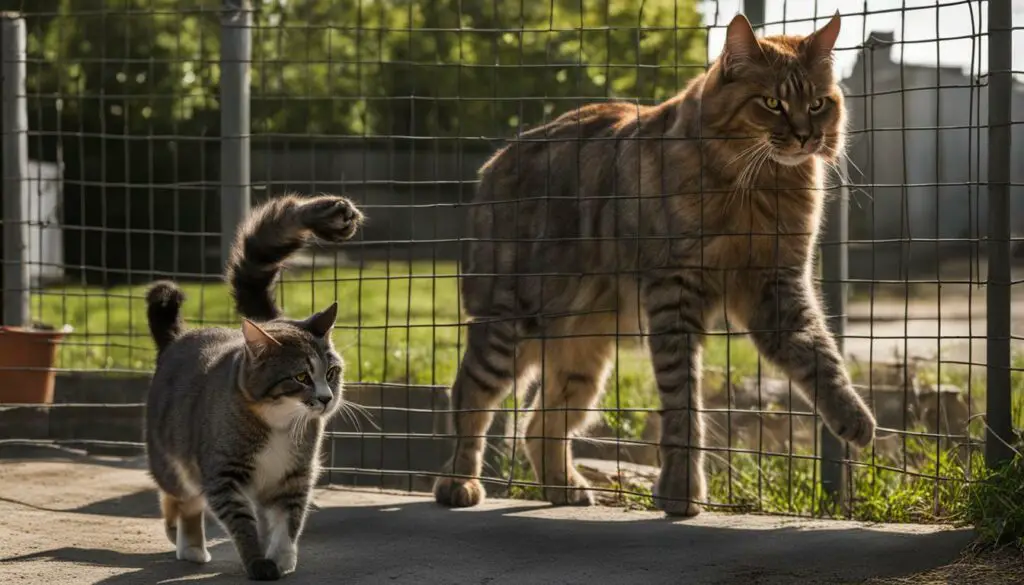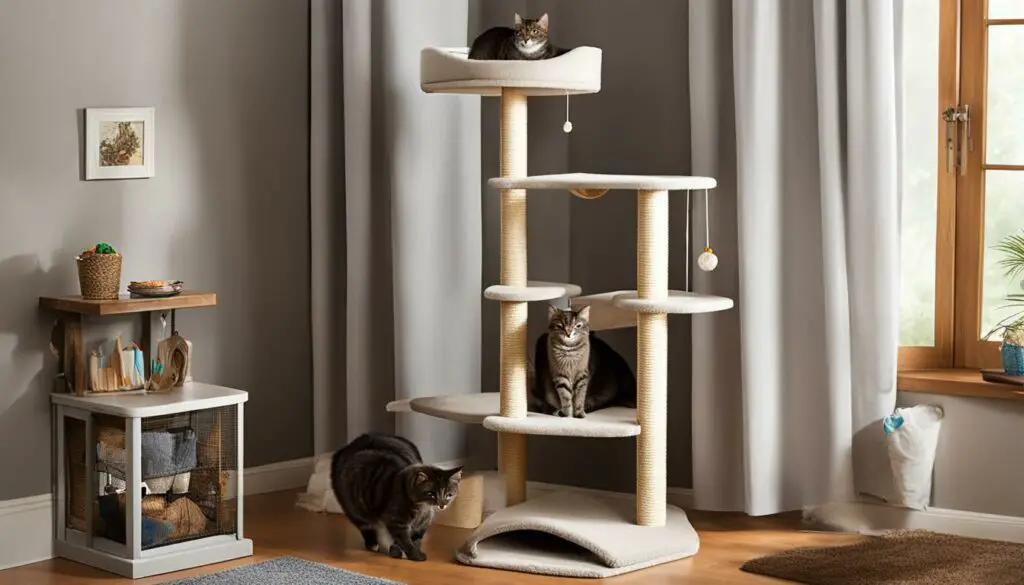Pet cats are wonderful companions, but sometimes they may need to be separated for their well-being. Whether it’s due to fighting, introducing a new cat, or creating a harmonious living environment, understanding the best methods for separating cats is essential. In this guide, I will provide you with expert tips and advice on how to separate cats efficiently and safely.
When cats fight or show tension, it can be distressing for them and may lead to physical symptoms or behavioral issues. It’s important to contact your vet for advice and consider working with a cat behaviorist. By addressing the underlying causes and creating a harmonious environment, you can help prevent conflicts and foster a peaceful coexistence.
Key Takeaways:
- Separating cats can be necessary for their well-being.
- Consulting a vet or cat behaviorist is important when dealing with cat fights or tension.
- Addressing the underlying causes of cat fights and creating a harmonious environment can help prevent conflicts.
- Providing each cat with their own resources, space, and opportunities for play is essential.
- Patience and understanding are key when assisting cats through the separation process.
Signs of Serious Fighting in Cats
When cats engage in serious fighting, it can be distressing for both the cats and their owners. Recognizing the signs of fighting is crucial in addressing the issue and seeking professional advice if necessary. Here are some common signs that indicate cats are engaged in serious fighting:
- Full-contact fighting: Cats lock together and engage in physical combat.
- Partial-contact fighting: Cats rapidly flail their paws at each other, often accompanied by hissing and growling.
- Aggressive body language: Cats display stalking behaviors, arch their backs, and adopt defensive postures.
- Aggressive sounds: Cats make hissing and growling noises as a warning or in response to threats.
It is also important to note that cats may display passive aggression, such as stealing resting places or staring at each other. These behaviors indicate tension between the cats and the need to address the underlying issues.
“When cats engage in serious fighting, it can be distressing for both the cats and their owners.”
If you observe any of these signs in your cats, it is essential to take action to resolve the conflict and create a peaceful environment for all involved.
| Signs of Serious Fighting in Cats | Description |
|---|---|
| Full-contact fighting | Cats lock together and engage in physical combat. |
| Partial-contact fighting | Cats rapidly flail their paws at each other, often accompanied by hissing and growling. |
| Aggressive body language | Cats display stalking behaviors, arch their backs, and adopt defensive postures. |
| Aggressive sounds | Cats make hissing and growling noises as a warning or in response to threats. |
Understanding the Reasons Behind Cat Fighting
When it comes to understanding why cats fight, there are several key factors to consider. One of the primary reasons for cat aggression is territorial behavior. Cats are naturally territorial creatures, and conflicts can arise when they feel their territory is being invaded or threatened. This territorial aggression can manifest in various ways, including hissing, growling, and physical fights.
Another reason for cat fighting is unfamiliar smells. Cats have a keen sense of smell, and if they detect unfamiliar scents in their environment, it can trigger a defensive response. This can be particularly common when introducing a new cat into a household or if a cat has been outside and picks up scents from other cats in the neighborhood.
Redirected aggression is another common cause of cat fighting. This occurs when a cat becomes aroused or agitated by something, such as seeing a bird outside the window, and then directs their aggression towards another cat or even their owner. This type of aggression can be particularly challenging to address, as the underlying trigger may not be immediately obvious.
Table: Common Reasons for Cat Fighting
| Reason | Description |
|---|---|
| Territorial Behavior | Cats may fight to defend their territory or establish dominance. |
| Unfamiliar Smells | Cats can become aggressive towards unfamiliar scents, such as those of new cats or other animals. |
| Redirected Aggression | When a cat is unable to direct their aggression towards the source of arousal, they may redirect it towards another cat or person. |
| Changes in Environment | Moving to a new home or introducing changes in the household can trigger stress and aggression in cats. |
Understanding the reasons behind the fighting is crucial in addressing the issue effectively. By identifying the specific triggers and underlying causes, cat owners can implement strategies to reduce aggression and create a more harmonious living environment for their feline companions.
Dealing with Cats Suddenly Fighting
If your cats have suddenly started fighting, it can be a distressing situation. The safety and well-being of both cats should be your top priority. Here are some steps to help you address the issue:
1. Separate the Cats Temporarily
The first step is to separate the fighting cats into different rooms for 24-48 hours. This will give them time to calm down and reduce the tension between them. Make sure each cat has their own essentials, such as food, water, a place to sleep, and a litter tray, in their separate spaces.
2. Gradually Reintroduce the Cats
After the temporary separation, you can start the process of reintroducing the cats to each other. This can be done by opening the doors and allowing them to see each other again. Observe their reactions closely. If the fighting resumes, it may be necessary to keep them apart for a longer period and gradually reintroduce them as strangers.

3. Seek Professional Advice if Necessary
If the cats continue to show aggression towards each other or if the fighting becomes more intense, it’s important to consult with a professional. A veterinarian or a cat behaviorist can provide guidance and help you develop a plan to address the underlying issues causing the fights.
Remember, patience and understanding are crucial when dealing with cats suddenly fighting. By taking the necessary steps to separate and reintroduce them gradually, you can create a harmonious living environment for your furry friends.
| Steps to Deal with Cats Suddenly Fighting |
|---|
| Separate the cats into different rooms for 24-48 hours |
| Provide each cat with their own essentials in their separate spaces |
| Gradually reintroduce the cats by allowing them to see each other |
| Observe their reactions closely and keep them separate if the fighting resumes |
| Seek professional advice if the aggression continues or intensifies |
Creating a Harmonious Living Environment for Cats
When it comes to cats living together, creating a harmonious environment is key to preventing conflicts and promoting a peaceful coexistence. By understanding the natural behavior of cats and providing them with the right resources, you can help foster a positive and social atmosphere in your home.
Separate Food and Water Bowls
One of the primary sources of tension among cats living together is resource competition, especially when it comes to food and water. To prevent conflicts, make sure to provide separate food and water bowls for each cat. This allows each cat to eat and drink at their own pace without feeling threatened or rushed.
Provide Multiple Resting Places
Cats are territorial animals, and having their own resting places is essential for them to feel secure. Make sure to provide multiple resting spots in different areas of your home, such as cozy beds, soft blankets, or cat trees. This gives each cat the opportunity to have their own space and reduces the likelihood of disputes over sleeping areas.
Offer Vertical Space and Interactive Play
In addition to physical resources, cats also need mental and physical stimulation. Providing vertical spaces, such as cat shelves or tall scratching posts, allows cats to climb, explore, and claim their territory. Interactive play, such as using feather toys or laser pointers, helps to release energy and strengthen the bond between cats living together.
| Key Tips for Harmonious Living |
|---|
| Separate food and water bowls |
| Provide multiple resting places |
| Offer vertical space and interactive play |
By implementing these strategies, you can create a harmonious living environment for cats. Remember that patience is essential during the adjustment period, and it’s important to monitor the interactions between your cats to ensure a peaceful coexistence. If you’re unsure about how to introduce new cats to your home or how to address conflicts, consider consulting with a professional behaviorist for guidance.

Preventing Fights Between Sibling Cats
When it comes to sibling cats, it’s not uncommon for them to engage in occasional fights, especially as they reach social maturity around 18 months old. While it may seem puzzling, these fights can be a result of natural instincts and the need to establish boundaries within their territory. As a cat owner, it’s important to understand the dynamics between your sibling cats and take steps to prevent fights.

One effective way to prevent fights between sibling cats is to provide outlets for their energy. Engaging in regular play sessions using interactive toys can help channel their natural hunting instincts and redirect their focus away from aggressive behavior. Additionally, incorporating enrichment feeding, such as using puzzle feeders or scattering their food in different areas, can also stimulate their minds and create a positive association with each other.
Creating a positive environment for bonding
To foster a strong bond between your sibling cats, it’s crucial to create a positive environment where they can feel safe and secure. This includes providing separate resources for each cat, such as food bowls, water bowls, scratching posts, and resting places. By ensuring that each cat has their own space and belongings, you can help reduce competition and potential triggers for fights.
Furthermore, monitoring their interactions and intervening when necessary is key to preventing escalation. If you notice any signs of tension or aggressive behavior, such as hissing or growling, it’s important to distract and redirect their attention to something positive. This can be achieved by using toys or treats to redirect their focus away from the potential conflict.
Remember, sibling cats can have a strong bond, but it’s important to create an environment that supports positive interactions and reduces the likelihood of fights. By providing outlets for their energy, creating separate spaces and resources, and monitoring their interactions, you can help promote a harmonious relationship between your sibling cats.
Introducing a New Cat into the Household
Introducing a new cat into your home can be an exciting but delicate process. It’s important to introduce the new cat gradually to minimize conflict and reduce stress for all cats involved. Here are some steps to follow when introducing a new cat into your multi-cat household:
- Designate a separate room: Choose a quiet, comfortable room where the new cat can stay initially. Provide essential resources like food, water, a litter tray, and a comfortable resting place.
- Gradual scent exchanges: Start by swapping scents between the cats. Rub a cloth or towel on each cat and place it in the other cat’s space. This helps them become familiar with each other’s scent without direct interaction.
- Supervised visual and scent exchanges: Allow the cats to see and smell each other through a cracked door or gate. Ensure these interactions are supervised to prevent any potential aggression.
- Reward positive interactions: Whenever the cats display calm and non-aggressive behavior towards each other, reward them with treats or praise. This positive reinforcement helps create a positive association between the cats.
Remember, the introduction process may take time, and it’s important to be patient. Each cat has its own unique personality and may require a different amount of time to adjust. By following these steps and giving each cat space and resources, you can increase the chances of a successful introduction and a harmonious multi-cat household.
“Introducing a new cat into your multi-cat household requires patience and careful planning. By following a gradual introduction process and providing each cat with their own space and resources, you can help minimize conflicts and create a harmonious living environment for all your feline companions.”
Introducing a new cat into a multi-cat household can be a rewarding experience for both you and your furry friends. By taking the time to properly introduce the new cat and provide a safe environment, you can help ensure a smooth transition and build positive relationships between the cats. Remember, each cat is unique, and the introduction process may vary depending on their personalities. If you encounter any difficulties or signs of aggression, consult with a professional behaviorist for guidance.

Dealing with Bullying from Neighborhood Cats
Living in a neighborhood with other cats can sometimes lead to territorial aggression and bullying. It’s important to create a safe and secure environment within your home to protect your cat from these unwanted interactions. Here are some strategies to help you deal with bullying from neighborhood cats:
1. Secure Your Home
To prevent access to your cat by neighborhood bullies, ensure that your home is secure. Install a microchip cat flap or a secure outdoor enclosure to keep other cats out. Secure windows and block off chimneys to eliminate potential entry points. Creating a barrier-free environment within your home will help your cat feel safe and reduce their stress levels.
2. Provide Vertical Space
Offering vertical space for your cat to escape and observe their surroundings can be a valuable tool in warding off bullying behavior. This can include tall cat trees, shelves, or designated high perches. Vertical space not only provides a safe retreat for your cat but also allows them to assert their dominance by occupying higher ground.
3. Avoid Confrontations
When encountering neighborhood cats, it’s best to avoid confrontations. Engaging in direct interactions can escalate tensions and potentially lead to fights. Instead, supervise your cat’s outdoor activities and be vigilant about their surroundings. If you notice a neighborhood cat approaching, calmly and gently redirect your cat’s attention or bring them back inside to prevent any potential altercations.
| Advantages | Disadvantages |
|---|---|
| Creating a secure environment | Potential need for additional security measures |
| Offering vertical space as an escape | Requires ongoing supervision |
| Preventing confrontations | May require constant vigilance |
By implementing these strategies, you can help protect your cat from bullying behavior and create a peaceful environment for them to thrive. Remember, your cat’s well-being should always be a top priority, so take the necessary steps to ensure their safety and happiness.

Preparing Your Home for a New Cat
Bringing a new cat into your home is an exciting time, but it’s important to ensure that your home is prepared to welcome your new furry friend. By taking a few simple steps to cat-proof your home and creating a settling room, you can provide a safe and comfortable environment for your new cat to adjust to their new surroundings.
Cat-Proofing Your Home
Before your new cat arrives, it’s essential to make sure that your home is free from any potential hazards. Take the time to carefully inspect each room and eliminate any potential dangers. Secure loose cords and cables, remove toxic plants from your home, and keep cleaning supplies and medications out of reach. By creating a safe environment, you can help prevent accidents and keep your cat healthy and happy.
Creating a Cat Settling Room
A settling room is a designated space where your new cat can adjust to their new surroundings and feel safe and secure. Choose a quiet room in your home where your cat can retreat to when they need time alone. Set up a comfortable bed, provide food and water bowls, a litter tray, and scratching posts. Additionally, you can enhance the room with a pheromone diffuser to create a calming atmosphere.
| Essential Supplies for a Cat Settling Room |
|---|
| Comfortable bed or blanket |
| Food and water bowls |
| Litter tray |
| Scratching posts or pads |
| Pheromone diffuser |
Having a dedicated space for your new cat will allow them to gradually explore and become acclimated to their new surroundings at their own pace. It’s important to remember that each cat is unique, and the adjustment period may vary. Patience and understanding are key as your new cat settles into their new home.

Settling Your Cat into Their New Home
Bringing your cat home is an exciting time, but it’s important to remember that cats need time and space to adjust to their new surroundings. During the initial days, create a settling room where your cat can feel safe and secure. This room should be quiet, with plenty of hiding spots and familiar items from their previous environment.
Allow your cat to explore the settling room at their own pace. They may initially hide and observe their surroundings. It’s crucial not to force interactions during this adjustment period. Instead, let your cat approach you when they feel comfortable. Spend time sitting quietly in the room, providing gentle reassurance and keeping interactions low-pressure.
As your cat begins to feel more confident, gradually introduce them to the rest of the house. Open the door of the settling room and let them explore one room at a time. Supervise their exploration to ensure their safety and monitor their reactions. If your cat becomes anxious or stressed, bring them back to the settling room and try again later.
“Creating a safe space for your new cat is essential during the adjustment period. By providing a settling room and gradually introducing them to the rest of the house, you’re giving them the opportunity to acclimate at their own pace.” – Professional Cat Behaviorist
Remember, every cat is unique, and the adjustment period may vary in length. Some cats may settle within a few days, while others may take weeks or even months. Patience and understanding are key during this time. Provide your cat with plenty of love, attention, and familiar items like bedding or toys. With time and a supportive environment, your cat will feel settled and at home in their new surroundings.
| Key Tips to Help Your Cat Settle: |
|---|
| 1. Create a settling room with hiding spots and familiar items. |
| 2. Allow your cat to explore the settling room at their own pace. |
| 3. Gradually introduce your cat to the rest of the house, one room at a time. |
| 4. Supervise your cat’s exploration and monitor their reactions. |
| 5. Be patient and provide love, attention, and familiar items for comfort. |
Transporting Your Cat to a New Home
When it comes to moving your cat to a new home, proper transportation is key to ensuring their safety and well-being. Cats can be sensitive to change and easily stressed by unfamiliar environments, so taking the necessary precautions is essential for a smooth journey. Here are some cat travel tips to help you transport your feline friend:
- Choose a secure cat carrier: Invest in a sturdy and well-ventilated cat carrier that provides enough space for your cat to move comfortably. Make sure the carrier is secure and has a reliable latch or lock to prevent any accidental escapes during transport.
- Create a comfortable environment: Line the carrier with a soft blanket or towel that carries the familiar scent of home. This will help your cat feel more at ease during the journey. You can also consider using pheromone sprays or calming aids to further reduce stress.
- Minimize car travel time: Cats are generally not fond of car rides, so try to keep the travel time to a minimum. Plan your route in advance to avoid heavy traffic or bumpy roads that could make your cat feel uncomfortable.
- Secure the carrier in the car: Place the carrier on the floor of the car, preferably in the backseat, and secure it with a seatbelt or by wedging it in place. This will prevent the carrier from sliding around or tipping over during sudden stops or turns.
- Maintain a calm and quiet environment: Cats are sensitive to noise and motion, so keep the car radio volume low and avoid sudden loud noises. Also, try to maintain a calm and relaxed atmosphere in the car to help your cat feel more secure.
- Take breaks when needed: If you’re embarking on a long journey, plan regular breaks to give your cat a chance to stretch their legs, use the litter box, and have a drink of water. Keep the carrier securely closed during these breaks to prevent any escapes.
Remember, each cat is unique, and their comfort levels during travel can vary. Some cats may feel more at ease with a blanket covering the carrier to create a cozy den-like environment, while others may prefer to see their surroundings. Observe your cat’s behavior during the journey and make adjustments as necessary to ensure their comfort and safety.
| Do’s | Don’ts |
|---|---|
| Do provide a comfortable and secure carrier for your cat | Don’t leave your cat unattended in the car |
| Do use familiar scents and calming aids to reduce stress | Don’t let your cat roam freely in the car |
| Do plan regular breaks for your cat to stretch and use the litter box | Don’t expose your cat to loud noises or excessive motion |
| Do keep a calm and relaxed atmosphere during the journey | Don’t rush the transportation process |
By following these cat travel tips and ensuring your cat’s comfort and safety, you can make the journey to their new home a stress-free experience for both of you. Remember to be patient and understanding, as it may take some time for your cat to adjust to their new surroundings. With proper care and attention, your feline friend will settle into their new home and continue to bring joy and companionship to your life.

Interacting with Your Cat in Their Settling Room
When it comes to interacting with your cat in their settling room, it’s important to remember that cats are sensitive creatures and may require some time to adjust to their new environment. Building trust and creating a positive bond is crucial in helping your cat feel safe and secure. To do this, it’s essential to observe and understand their body language, as it can tell you a lot about how they’re feeling.
Cats communicate through subtle cues, such as tail position, ear angle, and eye dilation. Pay attention to their body posture and whether they seem relaxed or tense. If your cat is standing tall with their tail held high and ears facing forward, it usually indicates they’re curious and open to interaction. On the other hand, if their tail is tucked between their legs and their ears are flattened, it’s a sign they may be feeling fearful or anxious.
Approach your cat calmly and gently, allowing them to initiate contact. Extend a hand for them to sniff and let them come to you at their own pace. Avoid making sudden movements or loud noises that may startle them. It’s important to be patient and respect their personal space. If your cat shows signs of discomfort or tries to move away, give them the space they need and try again later.
In their settling room, spend time engaging in activities your cat enjoys, such as playing with interactive toys or offering treats. Positive reinforcement is a powerful tool to encourage trust and build a bond. Remember, every cat is unique, and it may take time for them to feel comfortable and fully trust you. By understanding their body language and allowing them to set the pace, you can create a strong foundation for a loving relationship.

Cat Body Language
Cat body language is a fascinating and complex way of communication. Understanding their cues can help you better interpret their needs and emotions. Here are some common body language signals to look out for:
- Tail: A straight and upright tail usually indicates confidence and friendliness, while a puffed-up or fluffed tail may mean fear or aggression.
- Ears: Forward-facing and relaxed ears suggest a calm and content cat, while flattened or backward ears may indicate anxiety or aggression.
- Eyes: Dilated pupils often indicate excitement or fear, while slowly blinking eyes can be a sign of relaxation and trust.
- Posture: A relaxed and loose body posture indicates a comfortable and calm cat, while a tense or stiff body suggests stress or aggression.
“Cats communicate through subtle cues, such as tail position, ear angle, and eye dilation.”
Remember, each cat is an individual, and their body language may vary. It’s crucial to consider their overall behavior and context to accurately interpret their signals. By paying attention to their body language and responding appropriately, you can strengthen your bond and ensure a positive interaction with your feline friend.
| Body Language | Meaning |
|---|---|
| Tail held high and ears forward | Curiosity and openness to interaction |
| Tail tucked between legs and ears flattened | Fear or anxiety |
| Straight and upright tail | Confidence and friendliness |
| Puffed-up or fluffed tail | Fear or aggression |
| Forward-facing and relaxed ears | Calm and content |
| Flattened or backward ears | Anxiety or aggression |
| Dilated pupils | Excitement or fear |
| Slowly blinking eyes | Relaxation and trust |
| Relaxed and loose body posture | Comfort and calmness |
| Tense or stiff body | Stress or aggression |
Allowing Your Cat to Explore the Rest of the House
Once your cat has settled in their designated room and shows signs of relaxation and confidence, it is time to gradually allow them to explore the rest of the house. This step is crucial in expanding their territory and helping them feel more comfortable in their new environment. However, it’s important to proceed with caution and take the necessary precautions to ensure their safety.
When giving your cat access to new areas of the house, it’s recommended to start with one room at a time. Keep all escape routes securely closed to prevent any accidental escapes. Monitor your cat’s reactions closely during their exploration and be prepared to intervene if they show signs of stress or fear.
Remember, cats are creatures of habit, and sudden changes in their environment can be overwhelming. To help ease the transition, consider leaving their safe room open as a retreat for them to return to if they become overwhelmed or anxious. This will provide them with a familiar space where they feel secure.
| Tip | Explanation |
|---|---|
| Secure Potential Hazards | Remove any items that may pose a risk to your cat’s safety, such as toxic plants, chemicals, or small objects they could swallow. |
| Create Vertical Space | Install cat trees or shelves to provide vertical space for your cat to climb and explore, helping them feel more secure in their new surroundings. |
| Encourage Play and Exploration | Engage your cat in interactive play sessions and provide toys and puzzles to stimulate their curiosity and help them adjust to their new surroundings. |
“Allowing your cat to explore the rest of the house is an important step in their adjustment process. It gives them the opportunity to expand their territory and gain confidence in their new surroundings. Just remember to take it slow, provide a safe environment, and be patient with your furry friend.” – Cat Behaviorist
By gradually allowing your cat to explore the rest of the house, you are helping them feel more at home and establishing a sense of ownership over their new territory. Be mindful of their reactions and provide them with the necessary support and resources to ensure a smooth transition.
Letting Your Cat Outside in a New Environment
Introducing your cat to the great outdoors can be an exciting milestone in their life. Before allowing them outside, it’s important to ensure their safety and wellbeing. Gradual transition is key to prevent overwhelming your cat and reduce the risk of them getting lost or injured. Below are some essential steps to follow when introducing your cat to the outdoor environment:
Create a secure outdoor space
Prioritize the safety of your cat by creating a secure outdoor space for them to explore. This can be achieved by installing a cat-proof fence or enclosed catio. These enclosed spaces allow your cat to experience the outdoors while limiting their access to potential dangers, such as traffic or other animals. Providing ample climbing structures, hiding spots, and toys can also help enrich their outdoor experience.
Supervise initial outdoor adventures
When your cat is ready for their first outdoor adventures, it’s crucial to supervise their outings. Accompany them in the secure outdoor space and observe their behavior closely. Ensure they are comfortable and confident in their surroundings. Gradually increase their outdoor time, always keeping a close eye on them for any signs of distress or potential threats.
Use identification and microchipping
Before allowing your cat outside, make sure they are properly identified. Collars with tags containing your contact information are essential in case your cat goes missing. Additionally, microchipping your cat provides a permanent form of identification. Remember to keep your contact details up to date with the microchip registry to increase the chances of a safe return should your cat wander off.
| Outdoor Safety Checklist | Indoor Enrichment |
|---|---|
| Secure outdoor space (fenced yard, catio) | Scratching posts |
| Supervised outdoor outings | Interactive toys |
| Identification (collar with tags) | Hiding spots |
| Microchipping | Comfortable resting areas |
Remember that each cat is unique, and their readiness for outdoor exploration may vary. Some cats may prefer to remain indoors, while others thrive in an outdoor environment. Understanding your cat’s individual needs and preferences will help you make informed decisions regarding outdoor access. By following these guidelines and prioritizing safety, you can provide your cat with a stimulating and enriching outdoor experience.

Conclusion
After understanding the signs of serious fighting and addressing the underlying causes, separating cats effectively and safely is within reach. By creating a harmonious living environment and providing each cat with their own resources, space, and play opportunities, conflicts can be prevented and a peaceful coexistence can be fostered.
Temporary separation, gradual reintroduction, and professional guidance may be necessary steps in the process. Patience and understanding are key in assisting cats through the adjustment period and ensuring their well-being.
In conclusion, separating cats requires a thoughtful approach that takes into account their individual needs. By implementing the tips and methods outlined in this guide, owners can create a safe and harmonious environment for their feline companions, promoting their overall happiness and well-being.
FAQ
What are the signs of serious fighting in cats?
Signs of serious fighting in cats include full-contact fighting, partial-contact fighting, aggressive body language, and aggressive sounds.
Why do cats fight?
Cats may fight due to territorial disputes, unfamiliar smells, redirected aggression, or changes in the household environment.
How should I deal with cats suddenly fighting?
If your cats are suddenly fighting, the safest option is to separate them into different rooms for 24-48 hours. Reintroduce them gradually after they have calmed down.
How can I create a harmonious living environment for cats?
Creating a harmonious living environment for cats involves providing separate resources, like food and water bowls, multiple resting places, and vertical spaces.
Why do sibling cats fight?
Sibling cats may fight as they reach social maturity around 18 months old. Providing outlets for their energy and monitoring their interactions can help prevent fights.
How can I introduce a new cat into my household?
Introduce a new cat slowly and carefully by designating a separate room, gradually swapping scents, and rewarding positive interactions.
How should I deal with bullying from neighborhood cats?
Create a secure environment within your home and provide vertical space for your cat to escape. Avoid confrontations with the bully cat.
How do I prepare my home for a new cat?
Prepare your home by designating a settling room with essential resources and ensuring it is free of hazards and toxic plants.
How do I settle my cat into their new home?
Allow your cat time and space to adjust at their own pace by designating a settling room as their safe space and gradually introducing them to the rest of the house.
How should I transport my cat to a new home?
Use a secure carrier to keep your cat safe during the journey. Provide a comfortable environment within the carrier and take necessary precautions to prevent escape.
How should I interact with my cat in their settling room?
Let your cat take the lead and approach you on their terms. Respect their personal space and provide gentle and non-threatening interactions.
How do I allow my cat to explore the rest of the house?
Gradually allow your cat access to new areas, ensuring all escape routes are closed. Monitor their reactions and return them to their safe room at night.
When can I let my cat go outside in a new environment?
Allow your cat to go outside gradually after they have become familiar with their indoor environment and established a bond with you. Provide a secure outdoor space.
Can separating cats be done effectively and safely?
Yes, separating cats effectively and safely involves understanding the signs of serious fighting, addressing the underlying causes, and creating a harmonious living environment.








